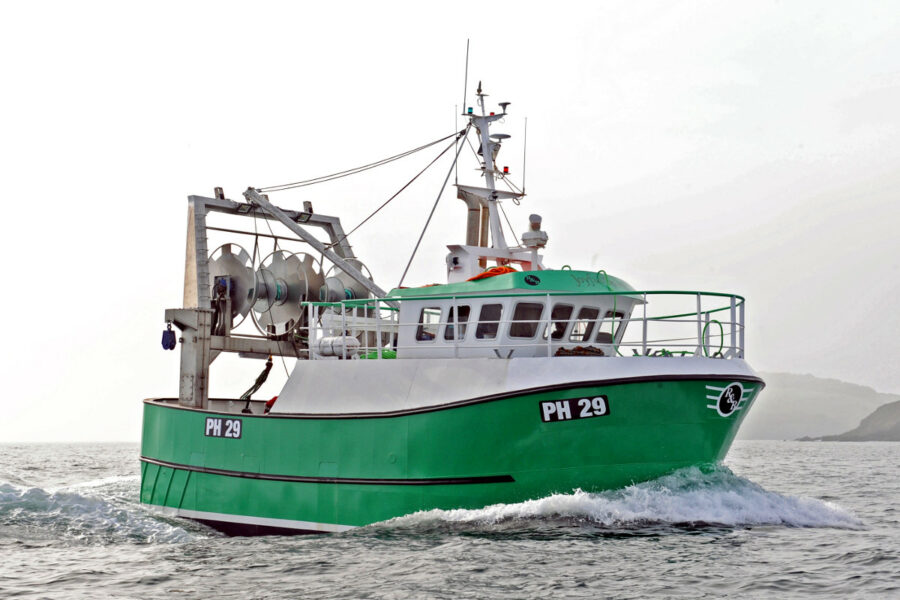Polruan boatyard completes ‘low-maintenance’ 11.95m twin-rig trawler
Described by marine architect Ian Paton as being ‘capable boats’, the latest build in his range of low-powered high-performance vessels is the twin-rigger Joyful Spirit PH 29, a vessel aimed at having the lowest possible running costs.
Of 11.95m LOA, Joyful Spirit has ‘quite a bit more’ fishing potential than its 12m predecessor, the wooden-hulled Hope SU 514, a single net/twin-rig trawler run by skipper Scott Govier from Polperro since its launch in 2003.
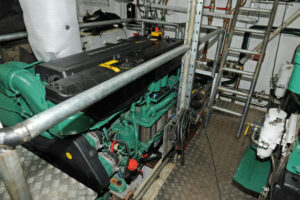
The Volvo Penta D13 MH main engine, supplied by Marine Engineering (Looe) Ltd, is providing impressive fuel consumption figures.
Both Joyful Spirit and Hope were built by the Westcountry yard of C Toms & Son, based in Polruan, Cornwall.
In its later stage of build, the Joyful Spirit changed ownership. A deal was clinched between its original owner, Terry Lankford, of Lankford & Sons (Fishing) Ltd, and Roger Klyne, the boss of R&B Fishing, Lowestoft, as an addition to his fleet of similar high-tech inshore trawlers.
“Following its recent launch, skipper Scott Govier and mate/crewman Scott Brehaut have clocked up impressive hauls”
Following its recent launch, skipper Scott Govier and mate/crewman Scott Brehaut have clocked up impressive hauls. Currently working from Plymouth and landing through Plymouth Trawler Agents (PTA), Joyful Spirit has attracted considerable interest from many who believe that its design and potential are the way ahead.

Joyful Spirit’s Spencer Carter three-drum trawl winch.
Although sad to leave Hope, Scott Govier says that the comparison between the two vessels is ‘the difference between chalk and cheese’. With both builds, skipper Govier had input into the build and fit-out; he praises Terry Lankford as being ahead of his time in pushing the efficiency of such boats to their present level.
Terry Lankford previously owned the Spirited Lady III, a similar boat to the Joyful Spirit and one many consider to be a benchmark by which others are measured. A dozen or so boats along the lines of the Spirited Lady III have been built, mostly by C Toms & Son.
“As far as I know, the design of Spirited Lady III was initially a one-off from designer Ian Paton of SC McAllister & Co Ltd,” said Terry Lankford.
“I often made trips to other European ports, mostly in France, gaining ideas on deck layout and other points, but Ian Paton’s hull design for Spirited Lady III bears no resemblance to the French boats. One of several boats that followed on from Spirited Lady III is New Seeker E 12, based at Lyme Regis, and the hull of the Joyful Spirit is an exact copy of New Seeker’s.

Seafish vessel surveyor Henry Millington at work, during the sea trials of the Joyful Spirit.
“However, the whaleback and superstructure of Joyful Spirit – and the interior too – is similar to the Spirited Lady III, so Joyful Spirit is a copy of two boats, not a copy of one. Designer Ian Paton has taken the best of both boats.
“The superstructure, engine choice and layout of Joyful Spirit were all decided as measures to cut overheads. Time lost in maintenance is always a cost, one that is always higher than first expected, and a cost that might cripple any fishing business.
“Stainless steel plate is used on the quarters, and also on the transom – on any place of wear that with ordinary steel would require regular painting. The gantry is also box-section stainless steel, with its upper section made of alloy. Between both metals is a plastic plate to prevent corrosion. So many boats with a normal steel gantry end up losing considerable fishing time chipping away old paint on a refit; Joyful Spirit is a ‘reduced-maintenance’ boat, and so is Spirited Lady III.
“It is crucial to reduce running costs and overheads. Getting a sensible profit as a trawler owner – to provide a good wage for all of those aboard – is all about the basic economics of fishing, and that applies to all fishing boats. For example, with Spirited Lady III, over the years of fishing alongside bigger boats and catching the same amount of fish, the fuel bill of Spirited Lady III remains a fraction of the money paid by the bigger boats. From the figures I hear quoted, the same outcome is now being shown by Joyful Spirit.
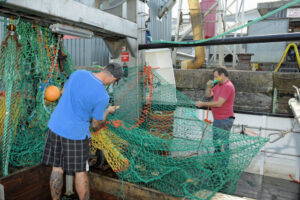
The deck space available onboard Joyful Spirit is impressive.
“We – Lankford & Sons (Fishing) Ltd – and our accountants use that formula; we take and record data over a given time period, based on the fuel burnt compared to the number of kilos of fish being caught. Keeping it in proportion to fuel prices and fish prices, that formula still works; it shows the difference between making a profit and making a loss. In simple terms, keeping the money in your back pocket rather than dishing it out is the difference between staying in business or not, and that is why Joyful Spirit is aimed at low overheads.
“Cropping the outgoings also applies to the choice of Joyful Spirit’s engine. In the Hope we had a Scania – a really good engine – but on the Joyful Spirit we chose a Volvo Penta – an equally good engine, but the choice was simply to reduce the overheads faced on maintenance. The switch to Volvo was not to reduce the cost of fuel consumption – both engines are comparable – but because the supplier of the Volvo engine and gen-set is Marine Engineering (Looe) Ltd, the Volvo Penta dealers based in Plymouth.
“For a large part of the year, Joyful Spirit will probably work from Plymouth”
“For a large part of the year, Joyful Spirit will probably work from Plymouth, and if it needs an engineer, he can be there in a matter of minutes. On Hope, when we required an engineer from Scania, they travelled from either Exeter or Redruth, so we had to pay a travelling charge on top of the bill, and over the years that adds up considerably. It always takes less work to save money than it does to earn money.”
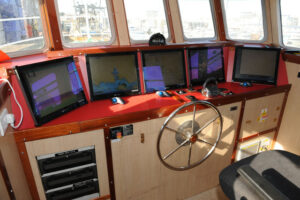
Wheelhouse interior.
Designer Ian Paton said: “The hulls of New Seeker and the Joyful Spirit are identical. Both have propulsion through a tunnel system, to keep the draft down but retain a good water flow to the propeller. Joyful Spirit is designed to be a good towing boat; as on the others, fins are fitted to the bulbous bow to reduce pitching, and for better steerage, fins are also fitted on the rudder.
“Joyful Spirit has a beam of 5.5m, but compared to boats like Harry Green’s 12m scalloper Judi G, which is now being completed – that has a beam of 6.1m.
“As far as the internal arrangements of Joyful Spirit are concerned, in comparison to the New Seeker, the fuel tanks have moved slightly further forward, the whaleback has been raised, and like on the Spirited Lady III, the shelterdeck has been extended to give better cover over the winch. A similar 12m boat is under construction at Ardmaleish Boatbuilding Company on the Isle of Bute.”
Skipper and crew
Skipper Scott Govier and mate Scott Brehaut praised the workforce at C Toms & Son for providing them with a ‘superb boat’, and describe the seakeeping of Joyful Spirit as ‘excellent’.
Skipper Govier commented: “We hadn’t had the boat long, and after a couple of days we got used to the boat’s movements; it is nothing like the last one, Hope, a good traditional boat that served me well for 15 years. But it wasn’t until the weather freshened that we realised how stable new designs like the Joyful Spirit are, having totally different seakeeping to a traditional hull.
“We were in poor weather, and started rolling, and we had left cups on the galley table, and neither of us had tied down the waste bin – a light plastic bin, the type found in any kitchen – so Scott rushed to the galley, and the cups were still on the table, and the bin was still in its place, and it was still upright. If we had been on Hope, that would not have been the case.
“Joyful Spirit rolls a bit with the sea on its quarter, but all boats do that. Compared to a traditional boat, ones like Joyful Spirit are like chalk and cheese. I’m so surprised how stable and comfortable Joyful Spirit is. And working on the boat is so much more efficient. It is far easier to handle the nets; the layout of winches and pounds has taken all the strain and backache out of working. Tasks we used to struggle with are now so easy.
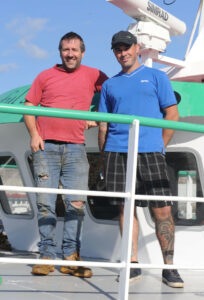
Skipper Scott Govier (left) with mate/crewman Scott Brehaut, after the maiden trip on Joyful Spirit last month.
“In Hope we didn’t lose many days in poor weather, when working alongside 15m boats. We didn’t head back to port very often – Hope is a fine boat – but I think Joyful Spirit will reduce those few days by a few more, and be more comfortable. From what I see so far, this boat will take a lot of poor weather before it becomes difficult to work.”
Scott Brehaut, who comes from Guernsey, agreed, saying that the Joyful Spirit is ‘a very efficient two-handed boat, and the entire layout and accommodation are really well made.”
Skipper Govier comes from the nearby scenic tidal port of Polperro, and has been a fisherman all his working life. Like Scott Brehaut, he decided to become a fisherman long before leaving school – though both tell how their teachers didn’t see fishing as a way ahead. As a result, both were all the more determined to succeed, and are now aboard one of the most advanced inshore trawlers in the UK.
“The boat is a lot like the Spirited Lady III, and I had quite a bit of input into the layout,” said Scott Govier. “I wanted the winch as big as possible, but I wanted to have a good view over the winch. I’ve been on other boats with bigger winches, and perhaps we could do with a bit more drum capacity, but only as a bonus – what we have is sufficient.
“It is a bit early to know the exact fuel consumption, but after three days’ fishing, plus all the trials and steaming to Plymouth after the launch, we have just filled the tanks with 1,690 litres. I would have expected the total to be about 2,300 litres, so it looks promising.
“The Scania on Hope was a good engine, but this Volvo, with the added hull efficiency, and the gearbox reduction of 5.95:1 plus the nozzle, is bound to give better figures. We were pushing the Scania on the Hope when twin-rigging. Twin-rigging was a bit too much for the Hope – but she did it, and did it well.
“I’m delighted with the new boat – though, like it always is after so long on one boat, I was sad to see the Hope go. She was a fine boat, and made a good wage for both me and the crew, but I felt it was time to move on.”
Full Hercules Hydraulics system design and installation
The complete hydraulic control package onboard Joyful Spirit was designed, supplied and installed by Hercules Hydraulics. This well-established hydraulics firm in Paignton has an extensive time-served record of support of the southwest fishing fleet.
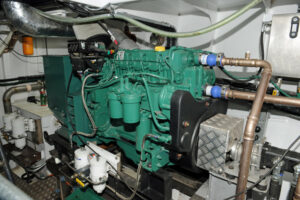
Joyful Spirit’s Volvo Penta D5 MG auxiliary/generator set.
Working very closely with Toms boatyard, and in conjunction with Spencer Carter, which manufactured the deck machinery, Hercules Hydraulics designed and fitted a system to a very high standard, built to last for heavy fishing.
The main hydraulic pump runs off the Volvo D13 propulsion unit, alongside a gear retrieve system driven from the D5 generator. The stainless steel piped system incorporates integrated cooling and a stainless hydraulic tank with inline filtration.
AMCA proportional valves are used throughout, with remote landing gear controls providing maximum levels of operational safety. Hercules Hydraulics also manufactured a wheelhouse control panel with built-in alarms, digital gauge and hydraulic safety isolation. Emergency stops are also fitted at the winch and net drums, providing a benchmark for future new-build installations by Hercules Hydraulics.
Spencer Carter deck machinery
Falmouth company Spencer Carter supplied the deck machinery on Joyful Spirit, including a three-drum winch with a mid-drum pull of 8t – ‘the type of winch required for that class of boat: very powerful, with the drums having big capacity’, said the firm’s technical manager, Richard Carter.
“That type of winch is now pretty standard on that design of boat, and all are made to the highest specification. Trawler skippers now want as much drum capacity as possible, and in each case, if the design of the boat will allow it, we provide what the skipper requires. The winch supplied to Joyful Spirit is almost identical to the one we supplied to the Spirited Lady III.
“We also supplied two elevated net drums, each having splitters on the core to take storage of various lengths of combination ropes, to enable the skipper to mix and match without having to keep all of the combinations on the winch drum. Again, storing unused combinations onto the net drum is now standard practice.”
MES electrics
The electrical systems on Joyful Spirit were designed, supplied and installed by Kevin Green of Marine Electrical Services (MES) of Falmouth.
Together with its 220V AC provisions, the Joyful Spirit has a 24V DC system to drive its LED lighting system.
Both powers are obtained from a three-phase generator (Volvo Penta D5 rated at 73kVA) delivering 415V AC fed to a mains distribution board. Three-phase output at 220V drives the refrigeration system.
“Joyful Spirit’s accommodation, galley and wheelhouse are also wired with USB sockets for electronics,” explained Kevin Green.
“A standard emergency back-up system has been fitted; if the generator fails, the team can switch over to an invertor driven from the battery bank, to give them a 240V back-up with a total power of 3kW.
“Although designed as an emergency system, it enables those onboard to not rely on having the generator running all the time – and to use the invertor system as an alternative.
“MES installed emergency stops, shut-off controls, gas alarms, fire alarms and four zones of bilge alarms and pumps on Joyful Spirit.
“Switch panels are custom-made by MES, and all equipment installed is top of the range. As always, all wiring used is Lloyds-approved heat-resistant tinned butyl cable.”
Wheelhouse electronics
The wheelhouse electronics and navigation package was supplied and installed by Tecmarine Ltd. From the early days of planning, skipper Scott and former owner Terry Lankford had made it clear that reliability and back up in the future was extremely important to them.
The chosen Simrad electronics package was installed under the ‘Simrad Certified Installation’ scheme which activates the Simrad onboard support, giving them the peace of mind they wanted. Tecmarine also supplied a second Traxnav Fish Pro V7 plotter on a Tecmarine brand ruggedized PC to complement the skippers’ own Traxnav V4 plotter and Icom VHF radios.
Tecmarine director Terry Smith said, “We have worked for many years with Terry Lankford, and we wish him well for the future and look forward to offering Scott and the vessel’s new owners R&B Fishing, a continued and reliable service in years to come.”
C Toms has space to start building more boats
Over the past few years, the leading South West boatbuilder C Toms & Son has built over 10 trawlers and/or scallopers designed by Ian Paton of SC McAllister & Co Ltd – of which the Joyful Spirit is one.
Joyful Spirit is the 12th to leave the yard, and with just two boats left under construction (15m scallopers), C Toms & Son has space to build more boats.
Yard leader Paul Toms said: “We are looking for orders to begin the keels by spring 2019. The two 15m scallopers should both be complete in about five months’ time, and naturally, we would like to carry on building. It takes time for the design, profiling and delivery of the steel to happen – normally three to four months – so now is a good time for anyone who is interested to get in touch and discuss what they want.
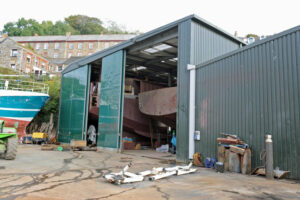
Two 15m scallopers, under build at C Toms & Son, are scheduled for completion by spring 2019. Paul Toms is looking for further orders.
“Joyful Spirit is a style of inshore boat that has become very popular, and reports say that the Ian Paton boat is a good investment. A 12m boat built to Ian’s design is a boat worth having; it has the fishing capabilities of a much larger boat – even a typical ‘big’ small boat from as little as 10 years ago is no comparison.
“Size for size, a boat like Joyful Spirit has no resemblance to what we were building 30 years ago, when I started working at the yard fulltime.
“Then, boats of 12m in length were like the Maxine’s Pride – but now, Maxine’s Pride could fit inside Ian Paton’s equivalent, and still have plenty of room left.
“Compare Maxine’s Pride and the 10m Palatine of Looe – top boats in their day – to Joyful Spirit (12m) and the Saxon Spirit (10m) – no boatbuilder two decades ago could have imagined that anything like the Joyful Spirit and Saxon Spirit would ever exist. When we built Maxine’s Pride and Palatine, they were pushing the limits then known by the designers.”
With 27 tradesmen including coded welders, C Toms & Son is the biggest South West yard, able to build several fishing boats at the same time. Paul Toms added, “We have a good turnaround on vessel refits; I can’t say that the yard has not been busy, because until recently we were. This time of year is normally a quiet time, and over the past couple of months three builds were completed – but I don’t want to end up in the springtime, with the scallopers ready to leave the yard, with no steel ready to start another build.
“We can build boats up to 19m in length, and for many years have used the firm Deri Jones & Associates Ltd in Machynlleth, Wales, where CAD and 3D modelling provide plans to produce a steel kit construction. We use steel fabricators and suppliers Snijtech in Holland to manufacture and deliver that kit.
“With Ian Paton, Deri Jones and Snijtech as a team, we always know what we will get: quality work, and a first-class steel kit that is delivered on time”
“With Ian Paton, Deri Jones and Snijtech as a team, we always know what we will get: quality work, and a first-class steel kit that is delivered on time. Computer profiling has come a long way over the years. We started using kit construction from CAD design a considerable time ago on the build of Jessica Grace FY 523, an under-10m trawler/scalloper built for skipper Dave Thomas of Fowey. Now, more than 20 years on, compare the hull of Jessica Grace to the hull shapes that fishermen want nowadays. There is no comparison; skippers want far more advanced technology. The construction of fishing boats has moved on.
“And all over the UK, the speed of a build, from start to finish, has become more important. Skippers can no longer wait; the cost of borrowing money is high, and the time-span from placing the order to collecting the boat has to be known – and we are always aware of that. With us having a tried and tested production line, sticking to the time-span decided and agreed is possible.
“As an example, after Ian Paton delivers the drawings to Deri Jones, who then supplies the required information and templates to Snijtech, the steel is cut and arrives at our yard – taking less than two months for the entire procedure. There is no comparison with what the schedules were like 20 years ago. With those two firms behind us, we can significantly shorten the build-time of most other yards. And there are not many yards of our size that can have five 10-15m boats under build at the same time, and we are well versed with the construction of Ian Paton’s designs.”
Ice machines for smaller boats
Alex Pino, boss of the refrigeration company Alpino Services, predicts that boats like the Joyful Spirit may in future have small-scale ice-making machines fitted.
He said: “Any of the Ian Paton 12m boats could have an ice machine fitted, and so could 10m equivalents like Saxon Spirit.
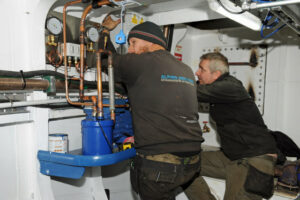
Alpino Services’ engineer Jamie Adams (left, with hat) and welder/fabricator Will Callaway put the finishing touches to the installation before insulating the pipework, ahead of Joyful Spirit’s running trials.
“Suitable ice machines are readily available. Space is sometimes limited, so if required, we literally fit the machine to the space available, by deconstructing the machine and piecing it back together in the fish hold. The only thing preventing a fishing boat from having an ice machine fitted is not having three-phase delivery from a generator – but most of the current boats do have three-phase.
“Previously, most inshore boats were not able to have suitable ice machines fitted because a single-phase ice machine, run from a small generator or from alternators, in most circumstances could not produce enough ice.
“But with the type of Ian Paton boats like the Saxon Spirit and above, there is no reason at all why an ice machine cannot be fitted. Most of those boats have three-phase power; it has to be 16kVA or more, but I believe they are all above that.”
Alpino Services installed the refrigeration system aboard the Joyful Spirit. Twenty-one metres of 22mm-diameter, grade 316 stainless steel pipe was used for the manufacture of the keel-cooling plate.
The refrigeration system in the fish hold runs as a single-circuit system on the deckhead. Its pipework is made from 90m of 22mm-diameter, grade 316 stainless steel pipe. Fitted over stainless steel sheet (1.5mm in thickness), 30m of 16mm-diameter piping was used for the bulkhead system.
Fabrications and pipework were done in-house by Alpino Services, and as on other vessels, the system on Joyful Spirit is controlled through a single panel mounted in the wheelhouse.
Complete fishing gear package from MarineCo
Gear supplier MarineCo, based in Saltash, near Plymouth, supplied the entire package of trawl gear to the Joyful Spirit.
Trawl designer and manufacturer Clive Palfrey explained: “We have supplied what has become a traditional rig for this type of twin-rig boat. This class of boat has evolved to become a major part of the South West fleet, and I don’t think the demand to have those boats built will stop.
“I’m not saying that the bigger boats are not doing well – many are – but inshore boats like Joyful Spirit are punching well above their weight, and size-for-size are surely the ultimate towing boats for the South West.
“Within the range of 12-13m two-handed twin-riggers – or six-a-side scallopers – whatever boat comes from Ian Paton’s design appears to succeed. Here in the Westcountry we have both crew and quota problems. Ian Paton’s design has answered that call, and I think more skippers will move to similar vessels.
“The package supplied to the Joyful Spirit is now relatively standard for the 12m twin-rigger gear. On the outer drums there are 12mm-diameter warps, right-hand lay on the starboard side, and left-hand lay on the port side. The clump wire is right-hand lay, and of 13mm in diameter. We always have the clump warp slightly bigger in diameter to take account of the weight and strain. The wires we supply are made to our specifications.

Clive Palfrey at MarineCo says Randers’ combination ropes are the best available.
“The combinations we supplied to Joyful Spirit are Randers. In my opinion, Randers make the best combination presently available. We have supplied a set of four 100-fathoms-long pieces of 28mm diameter; all have four-strand and fibre-core construction. Obtained through Coastal Nets in Bridport, we supplied a set of Polar doors (from the Hercules 1.2r range), each with 2.2m² of surface area. Polar doors are becoming very popular across the fleet of similar boats; skippers seem to favour just three makes – Polar, Bison and the semi-pelagic Thyborøn doors.
“All fishing gear and engines – all sorts of things in fishing – are forever in or out of favour, and the sales of most products show the same trend. The current call to use semi-pelagic doors is because the boats are using long gear – using the longest bridles possible, to get as much spread as possible. And with the gear being a long way behind the doors, there isn’t so much snatching tension on the doors, so skippers can choose a lighter door, having smaller skids and less drag. The doors are also well vented, and ultimately give a fuel saving.
“Everything else in the package for Joyful Spirit is standard: 12-fathom splits, and Scott has chosen a heavy combination wire on the bottom (32mm in diameter) and a 14mm-diameter combination for the top. The nets supplied are our normal 12-fathom Palfrey twin-rig set – gear designed and made at MarineCo. The boats are chasing species like cuttlefish and monkfish, as well as lemon sole and squid, and there is sufficient lift. Twin-rigging is generally not for round fish, but its capture is still important – but for most skippers, not having extra lift in the net isn’t a major factor. Also, from our findings, higher-lift twin-rig nets are no better at herding more squid into the net. We use 6in- and 8in-diameter discs in the foot rope, and danglers (chain) in the centre, to give a bit more weight.”
MarineCo is finding it progressively more difficult to obtain suitable rubber discs, and MarineCo boss Chris Dinham invites manufacturers of industrial moulded-rubber discs to get in touch to discuss the possibility of making such discs specifically for the firm’s trawl nets.
Clive Palfrey explained, “Nowadays, a greater amount of wire is being used in the manufacture of both car and lorry tyres. Those tyres are no longer suitable, and as a result, most of our rubber discs come from discarded tyres of earth-moving trucks. There are far fewer of those vehicles, so for trawl makers, getting discs is very difficult.”
Discards ban
To address the forthcoming discards ban, MarineCo is introducing a new range of ‘Greener Trawls’.
Net designer Clive Palfrey explained: “To catch less of whatever become choke species, we have redesigned many nets within our range; some of the Greener Trawls are of lower lift, to avoid haddock and other such species. Some nets have increased mesh sizes to reduce discards as much as possible. The new Greener Trawls are modified in all sorts of ways to try to avoid the inevitable damage to fishermen’s income that the discards ban might bring.
“The new Greener Trawls are there to give more selective fishing. The next few years will be a very interesting period. British fishermen will have to cope with the discards ban, and quite what will happen after Brexit is also a worry to many.”
Will he retire?
Based at Hythe near Southampton, Terry Lankford, head of Lankford & Sons (Fishing) Ltd, was the original owner of Joyful Spirit. Its sale during the build was Terry’s preparation for retirement – but will that ever happen?
As a life-served fisherman, and later fish wholesaler, he has seen the UK fishing industry suffer at the hands of the EU’s Common Fisheries Policy, and is a staunch Brexiteer, but not an opponent of Europe – and it was during his many visits to ports around Europe that his ideas for the ‘best boat’ layout were forged.
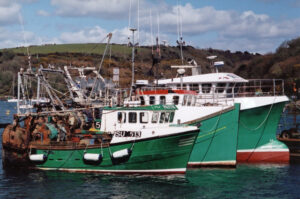
The Lankford & Sons (Fishing) Ltd fleet of Faith, Hope, and Charity & Liberty.
While his initial mainstay was the catching and selling of oysters and clams, obtaining whitefish was also important – but the Solent remains a hard place from which to make a serious living as a trawlerman.
In the mid-1990s, Looe skipper Clive Palfrey visited Southampton and met Terry Lankford. He saw Terry’s boat, the 12m steel-hulled Kathleen, rigged as an oyster boat. Its hull was a perfect base to become a trawler for fishing the Cornish waters.
Clive Palfrey explained: “Having met Terry, I told him of the trawling at Looe, and he asked me to skipper the Kathleen and take it to Looe, where he saw his returns from trawling increase. We did well on the Kathleen; it was a good boat. In 1995, Terry’s confidence in the Westcountry industry grew, and he ordered Faith SU 513, a Cygnus Marine GM33 that became the second boat in the firm’s fleet. I moved from the Kathleen to skipper Faith, and Dave Peach from Looe skippered Kathleen.”
After several years, Clive stepped ashore to study trawl design and manufacture, with Plymouth trawl-maker Stan Stanley guiding his way. Clive Palfrey is now a major trawl designer, manufacturer and supplier, from the gear firm MarineCo.
He added, “After I left Faith, Looe skipper Steve Fisher took over, and his success encouraged Terry Lankford to invest further. Terry ordered the 12m steel trawler Charity & Liberty – built at C Toms & Son – and Steve Fisher moved on to skipper Charity & Liberty. Terry Lankford later had a wooden 12m boat built, Hope; that was skippered by Scott Govier, now the skipper of Joyful Spirit.
“Terry Lankford’s investments have been a major factor in the development of the region’s inshore trawling industry.”
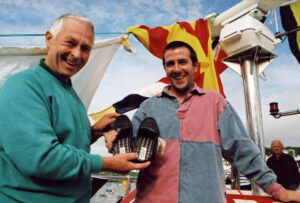
In 2003, Terry Lankford passed the keys of the newly-built vessel, the Hope, to skipper Scott Govier – his present of slippers was to enjoy the comfort of the new boat. Fifteen years on, the Joyful Spirit will be even more comfortable.
Terry Lankford explained, “There’s no big secret about buying new boats. Since we found that Looe fishermen were first-class, and that they manned our boats very well, any profit from those boats was poured back into a boat fund.”
While Lankford & Sons’ fleet of trawlers has been sold as a measure to prepare Terry for retirement, he admits that he’s waiting for a newly-built K26 GRP boat to arrive – ‘just to keep me busy’.
His determination to echo the feelings of 52% of British people is locked into the names and numbers of the Lankford boats, as far back as when the Faith was launched in 1995. ‘Faith’ was a statement of Terry Lankford’s belief that one day Great Britain’s future would be outside the EU – a tall order 20 years ago, when the fishermen of the UK were at continual loggerheads with the fisheries management of Brussels.
‘Hope’ to one day be free from Brussels remains locked in the woods of that 12m vessel, and ‘Charity & Liberty’ (and independence from the EU) is further testament to Terry’s feelings. Looking at the registration numbers of his vessels tells more.
He explained, “Joyful Spirit is registered as PH 29, because on 29 March next year Britain will leave the EU, and at last have its day of independence.
“Initially, the Joyful Spirit was to be called just ‘Joy’ – to reflect the joy of Britain’s independence. My new K26 will be registered in Portsmouth as P 29, and will be called Spirited Lady IV. I wanted to call it ‘Liberty from the EU’, but that wouldn’t pan out on the VHF radio!”
Tradesmen working at C Toms & Son can reveal something about the Joyful Spirit that is no longer apparent. Before its ownership was transferred to Roger Klyne, most of whose vessels are painted in green, the Joyful Spirit bore the proud colour of UKIP – purple!
JOYFUL SPIRIT PH 29
DETAILS
Owners: Roger Klyne, R&B Fishing, Lowestoft
Designer: SC McAllister & Co Ltd
Boatyard: C Toms & Son Ltd, Polruan
DIMENSIONS and CAPACITIES
Length overall: 11.95m; Length reg: 11.41m; Beam: 5.5m; Depth moulded: 2.89m; Fuel: 5,000 litres; Freshwater: 500 litres; Fishroom: 100 boxes
ENGINEROOM
Main engine: Volvo Penta D13 MH driving through a ZFW 350 5.95:1 reduction gearbox to a 1,600mm-diameter four-bladed propeller with nozzle
Auxiliary engine: Volvo Penta D5 MG generator
DECK MACHINERY
Supplier: Spencer Carter – three-drum trawl winch, 5t mid-drum pull; 2 x single net drums, 3t; 1 x landing winch, 1t
FISHROOM CHILLING
Supplier: Alpino Services
ELECTRONICS
Supplier: Tecmarine Ltd (Plymouth and Brixham)
FISH DETECTION
Simrad SonarHub – BB sounder module with CHIRP technology, StructureScan HD and Simrad NSO Evo II
NAVIGATION
Simrad 6kW radar; Simrad A2004 autopilot; 2 x TRAX plotters
COMMUNICATIONS
Icom M323 and M330 DSC VHFs
FISHING GEAR
Warp supplier: MarineCo; Net supplier: MarineCo; Trawl doors: Polar Neptune from MarineCo, Saltash
ACCOMMODATION
1 x two-berth cabin
GENERAL
Engine controls: Volvo; Steering: Wills Ridley

